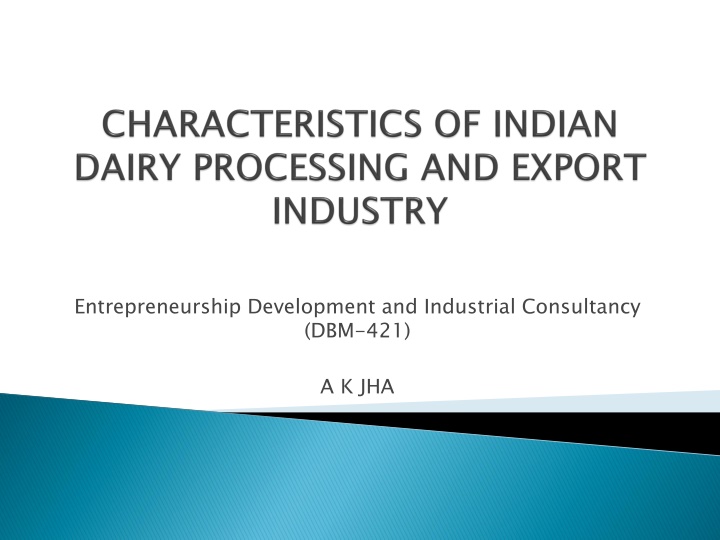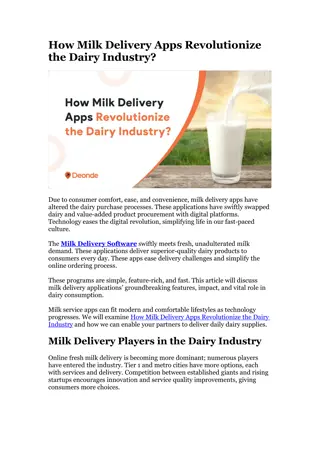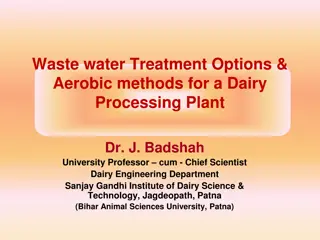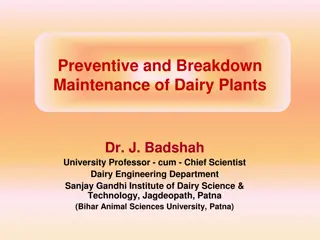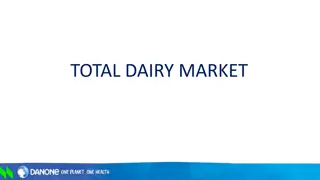Challenges and Opportunities in the Indian Dairy Industry
The Indian dairy industry is characterized by the dominance of smallholder milk producers, with over 150 million farmers involved in production. Despite being the largest milk-producing country, India faces challenges such as low productivity of milch animals and the need for quality control mechanisms. However, there are opportunities for improvement through policy measures like enhanced breeding programs and disease control initiatives.
Download Presentation

Please find below an Image/Link to download the presentation.
The content on the website is provided AS IS for your information and personal use only. It may not be sold, licensed, or shared on other websites without obtaining consent from the author.If you encounter any issues during the download, it is possible that the publisher has removed the file from their server.
You are allowed to download the files provided on this website for personal or commercial use, subject to the condition that they are used lawfully. All files are the property of their respective owners.
The content on the website is provided AS IS for your information and personal use only. It may not be sold, licensed, or shared on other websites without obtaining consent from the author.
E N D
Presentation Transcript
Entrepreneurship Development and Industrial Consultancy (DBM-421) A K JHA
Indian dairy industry is unique in production, processing, marketing and consumption of milk . Dominance of smallholder milk producers. More than 150 million producer farmers Production is scattered and carried out by a large number of farmers. Very small herd size Milk producers generally keep one or a few dairy animals. Low productivity of the dairy animals. More than 50% of the milk produced is consumed by the producing households. Marketable surpluses are tiny Which is mostly sold as liquid milk through various formal and informal channels. Many of the milk producers are members of co-operative dairy set up and supply their milk to village cooperative dairy society. The remaining producers, sell their milk to private traders.
Indian dairy industry is unique in production, processing, marketing and consumption of milk . Dominance of smallholder milk producers. More than 150 million producer farmers Production is scattered and carried out by a large number of farmers. Very small herd size Milk producers generally keep one or more dairy animals. Productivities of the dairy animals are low. More than 50% of the milk produced is consumed by the producing households. Marketable surpluses are tiny Which is mostly sold as liquid milk through various formal and informal channels. The milk producers may be members of co-operative dairy set up and supply their milk to village cooperative dairy society. Those who are not associated with any cooperative set up, sell their milk to private traders.
Although India is the largest milk producing country in the world. Milk Production was 187.7 million tons in 2018-19 (NDDB) Per capita availability : 394 gms/ day/person The production is often constrained with a) Low productivity of milch animals. b) Lack of quality control and monitoring mechanism.
India : World dairy animal stock 17%, World milk production 15% USA: World dairy animal stock 6%, World milk production 12.5% Average milk productivity Crossbred cows 6.44 kg/day Indigenous cows 1.97 kg/day Buffaloes 4.3 kg/day Wide inter-state and inter-district variations
India has largest number of milch animals but their productivity in terms of milk output is very low. This requires appropriate policy measures viz., improved breeding programme, maximum use of artificial insemination; balance feeding, implementing disease control programme etc.
The bacteriological quality of raw milk is also poor. Due to existence of unhygienic conditions at the place of milking conditions give rise to very high bacterial count. Thus bacteriologically, the quality of milk in India is very poor compared to developed and western nations. This acts as a draw back on export front. The major reason for this condition is lack of awareness among milk producers and lack of incentives for clean milk production. By arranging requisite training programmes for milk producers and providing incentives in the form of higher milk price, and technology up gradation in collection and storing raw milk will help to improve quality of milk. and then improper subsequent storage
Low processing About 35 per cent of milk produced in India is processed Organised sector : 13-15% Mainly pasteurized milk
Of the total milk produced only about 35 percent is processed. The share of organized sector is less compared to unorganized sector. The organized sector comprises of dairy processing plants owned by cooperatives and private business. The unorganized sector comprises of halwaies and milk vendors. As only limited amount of milk is processed and handled by organized sector, there exists a vast growth potential. After deliciensing of dairy sector, the milk processing capacity has grown at 4 percent. More number of plants has come up in private sector as compared to cooperative set up. Problematic issues on processing front include seasonal and regional imbalances and limited flexibility to change product mix, lack of commercialization and government taxation.
India is largest milk producing country in the world, however it is a minor player in world dairy market. Export of dairy products from India is negligible and there is need based occasional import in small quantities. From India, the export of dairy products has increased to countries like Bhutan, Afghanistan, Canada, Egypt, and the United Arab Emirates. India has also imported a significant amount of dairy products from countries like France, New Zealand, Ireland, France, Ukraine, and Italy. Indian milk producer does not receive any subsidy. Thus in post WTO world there is possibility that Indian milk products cannot compete with those from many developed nations which dominate global dairy market. In liberalized WTO era, export opportunities are unavailable to Indian dairy establishments and they are getting ready to face the emerging challenge by meeting international standards and other non tariff barriers.
In 2018-19, Indias dairy exports rose 126 per cent to 1,23,877 million tonnes (MT) roughly estimated to be worth Rs 2,700 crore from 54,828 MT in the previous fiscal, according to the Ministry of Animal Husbandry, Dairying and Fisheries. Skimmed milk powder, casein products, butter, ghee, cheese, cream and curd are the several kinds of milk products that are exported by India. Among these, skimmed milk powder saw the largest growth at 292 per cent. Turkey, UAE, Egypt, Bangladesh and Bhutan are the major markets for India s dairy exports.
The individual products under this sub The individual products under this sub- -head are as below: head are as below: Butter Fresh Butter Oil Milk & Cream in Powder Other Fat Other milk power Ghee Butter MilK Fresh Cheese Milk for Babies Skimmed milk powder Whole Milk India's Export of Dairy products was 1,13,721.70 MT to the world for the worth of Rs. 2422.85 Crores/ 345.71 USD Millions during the year 2018-19. Major Export Destinations (2018 Emts, Egypt A Rp, Bangladesh Pr and Bhutan. Major Export Destinations (2018- -19) : 19) : Turkey, U Arab
The major problem faced for exploring Dairy Products include, i. ii. their dairy sector. iii. High level of market prices supports subsidies. iv. Impregnable market due to high tariffs and pay to sanitary (SPS) norms. Poor microbiological quality of milk. Domestic support provided by OECD Countries to
